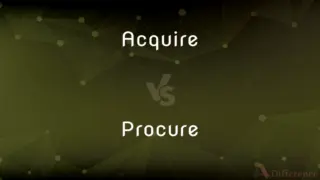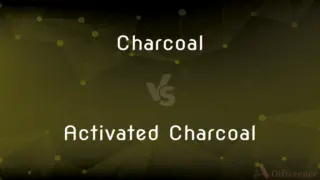Chemical Reaction vs. Physical Reaction — What's the Difference?
By Maham Liaqat & Urooj Arif — Published on July 22, 2024
Chemical reactions involve the rearrangement of atoms and change substances into different ones, while physical reactions involve changes in state or appearance without altering the chemical composition.

Difference Between Chemical Reaction and Physical Reaction
Table of Contents
ADVERTISEMENT
Key Differences
In a chemical reaction, substances undergo changes that transform them into entirely different substances. These reactions are characterized by the breaking and forming of chemical bonds, leading to the production of one or more new substances with new chemical and physical properties. Indicators of a chemical reaction include color change, temperature change, the formation of a precipitate, or the evolution of gas.
Physical reactions, alternatively referred to as physical changes, do not alter the chemical identity of the substance involved. They often involve changes in the state of matter (solid, liquid, gas) or the physical form of a substance. Examples include melting, freezing, dissolving, and evaporation. Despite these changes, the underlying molecules retain their original chemical properties.
A key distinction between the two is the reversibility under ordinary conditions. Physical changes are generally reversible, whereas chemical reactions are often irreversible. For instance, water can freeze into ice and then melt back into water, but once a candle burns, it cannot revert to its original state.
Chemical reactions are fundamental to various processes in nature and industry, such as photosynthesis, combustion, and rusting. They are crucial in fields like pharmaceuticals, energy production, and materials science. Physical reactions, on the other hand, are pivotal in processes like phase transitions, mixing, and changes in physical form, playing essential roles in cooking, construction, and manufacturing.
Understanding the difference between chemical and physical reactions is crucial in chemistry, as it helps in predicting the outcome of experiments, the properties of substances, and the feasibility of certain processes. This distinction also aids in the proper classification of changes observed in laboratory and industrial settings.
ADVERTISEMENT
Comparison Chart
Nature of Change
Changes in chemical composition
Changes in physical state or appearance
Bond Alteration
Involves breaking and forming of chemical bonds
Does not involve bond breaking/forming
Reversibility
Often irreversible
Generally reversible
Energy Change
Often involves absorption or release of energy
Involves physical changes like change in energy state
Example
Burning of wood
Melting of ice
Compare with Definitions
Chemical Reaction
Characterized by energy changes.
Combustion releases heat and light.
Physical Reaction
No chemical bonds are broken or formed.
Stretching a rubber band changes its shape but not its chemical structure.
Chemical Reaction
Often irreversible.
Baking a cake cannot be undone to retrieve the original ingredients.
Physical Reaction
Involves changes like melting, freezing, and evaporation.
Freezing water into ice cubes.
Chemical Reaction
Involves the rearrangement of atoms.
Combining hydrogen and oxygen to form water.
Physical Reaction
Involves changes in physical state without altering chemical identity.
Water boiling into steam.
Chemical Reaction
Indicated by color change, gas evolution, or precipitate formation.
Silver nitrate and sodium chloride react to form a white precipitate of silver chloride.
Physical Reaction
Often reversible.
Water vapor can condense back into liquid water.
Chemical Reaction
A process that changes substances into different substances.
Rusting of iron produces iron oxide.
Physical Reaction
Does not involve new substance formation.
Dissolving sugar in water.
Common Curiosities
Why is it important to distinguish between chemical and physical reactions?
Understanding the difference helps in predicting outcomes of reactions, designing experiments, and understanding material properties in science and engineering.
How can you tell a chemical reaction has occurred?
Indicators include color change, temperature change, gas evolution, or precipitate formation.
Are physical reactions always reversible?
While generally reversible, some physical changes under specific conditions might be hard to reverse, like glass shattering.
What happens to atoms in a chemical reaction?
Atoms are rearranged, forming new substances with different properties from the reactants.
Can the formation of a mixture be considered a chemical reaction?
No, mixing substances without changing their chemical identities is a physical change.
What defines a chemical reaction?
A chemical reaction involves the transformation of substances into different ones through the breaking and forming of chemical bonds.
Can a change be both chemical and physical?
Some processes involve both changes; for example, burning sugar changes its chemical composition (chemical) and also results in a change in state from solid to liquid and gas (physical).
What role do catalysts play in chemical reactions?
Catalysts speed up chemical reactions without being consumed, affecting the reaction rate but not the nature of the products.
Can physical changes affect the visibility of substances?
Yes, physical changes can alter appearance, texture, or phase without changing the substance’s chemical nature.
Do physical reactions involve energy changes?
They involve changes in the physical state or form, which may require or release energy, but don't involve bond energy changes inherent to chemical reactions.
What is an example of a reversible chemical reaction?
The synthesis of ammonia from nitrogen and hydrogen is reversible under certain conditions.
How does the conservation of mass relate to chemical reactions?
The total mass of reactants equals the total mass of products in a closed system, illustrating the conservation of mass.
How do temperature changes indicate a chemical reaction?
Exothermic reactions release heat, while endothermic reactions absorb heat, indicating a chemical process.
Why might a physical change be difficult to reverse?
While theoretically reversible, practical limitations or specific conditions might make reversing the change challenging, like compacting snow into ice.
Is dissolving salt in water a chemical or physical reaction?
It's a physical reaction because the chemical identity of salt remains unchanged.
Share Your Discovery

Previous Comparison
Acquire vs. Procure
Next Comparison
Vinyl Flooring vs. Hybrid FlooringAuthor Spotlight
Written by
Maham LiaqatCo-written by
Urooj ArifUrooj is a skilled content writer at Ask Difference, known for her exceptional ability to simplify complex topics into engaging and informative content. With a passion for research and a flair for clear, concise writing, she consistently delivers articles that resonate with our diverse audience.










































